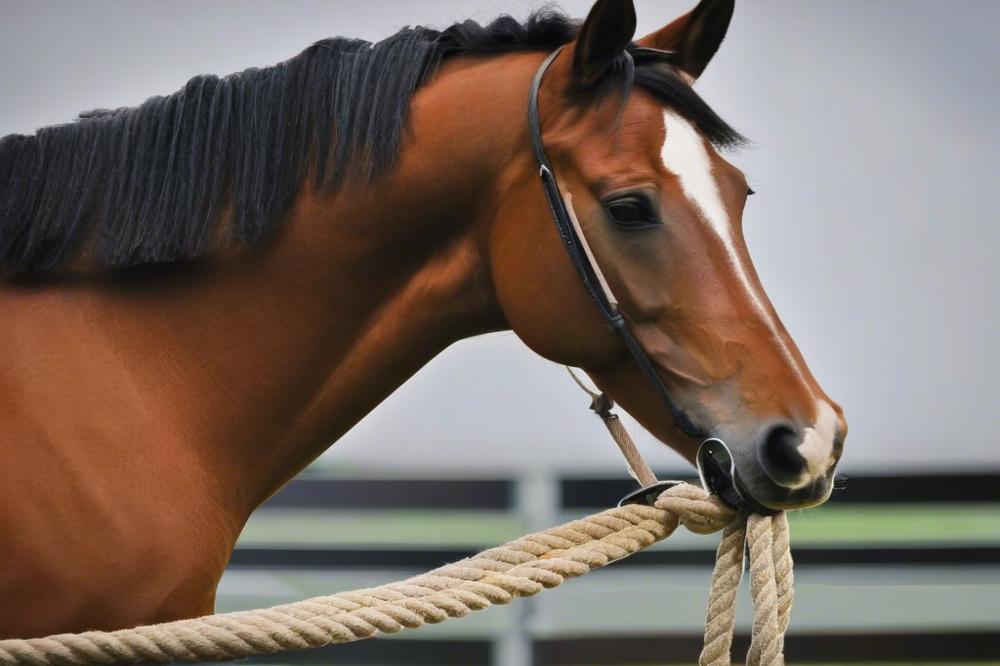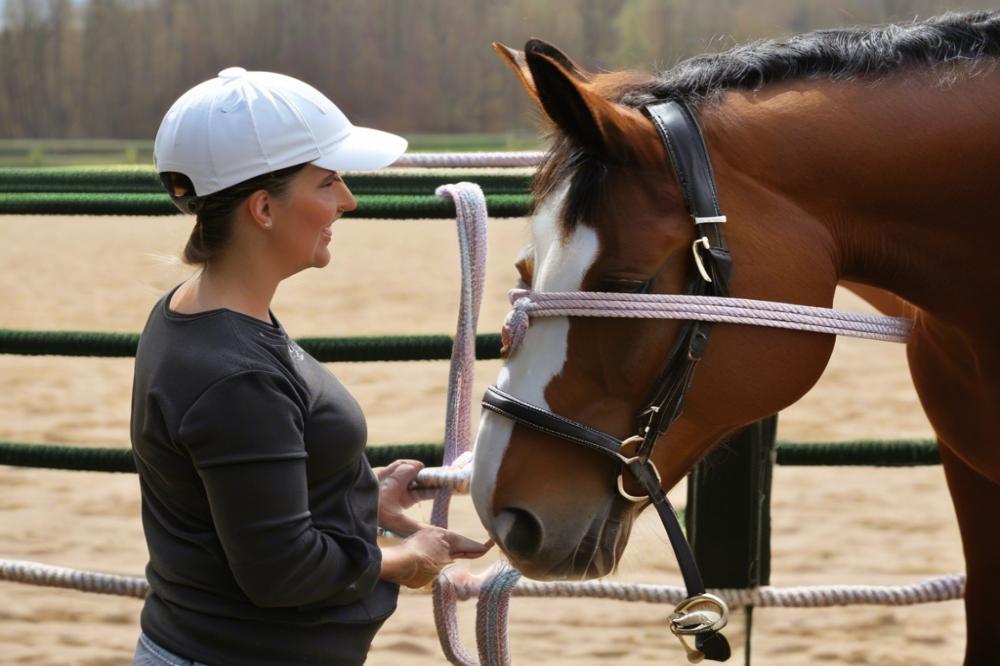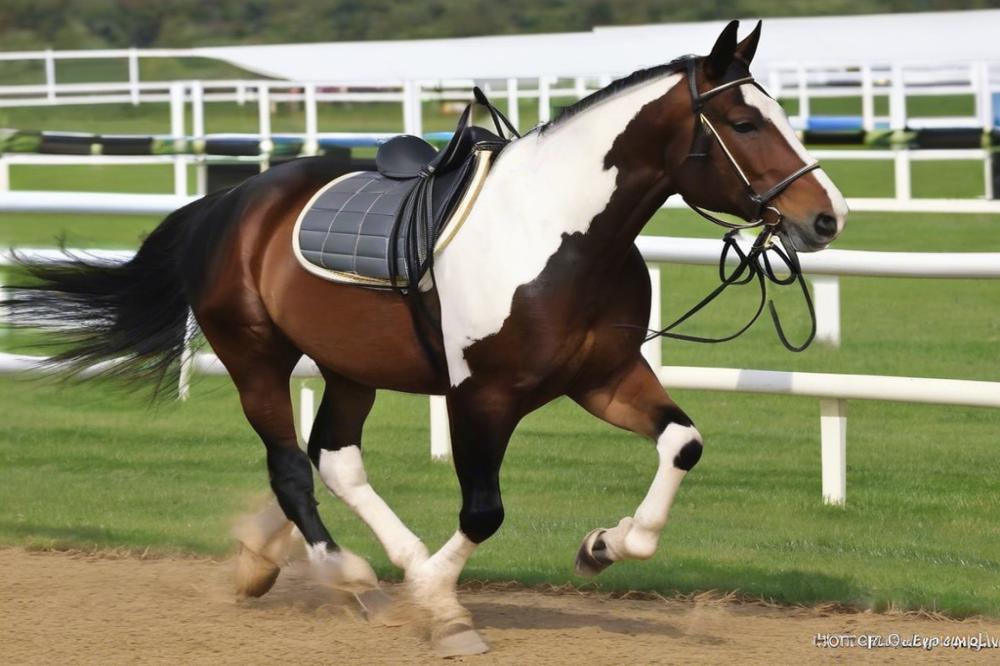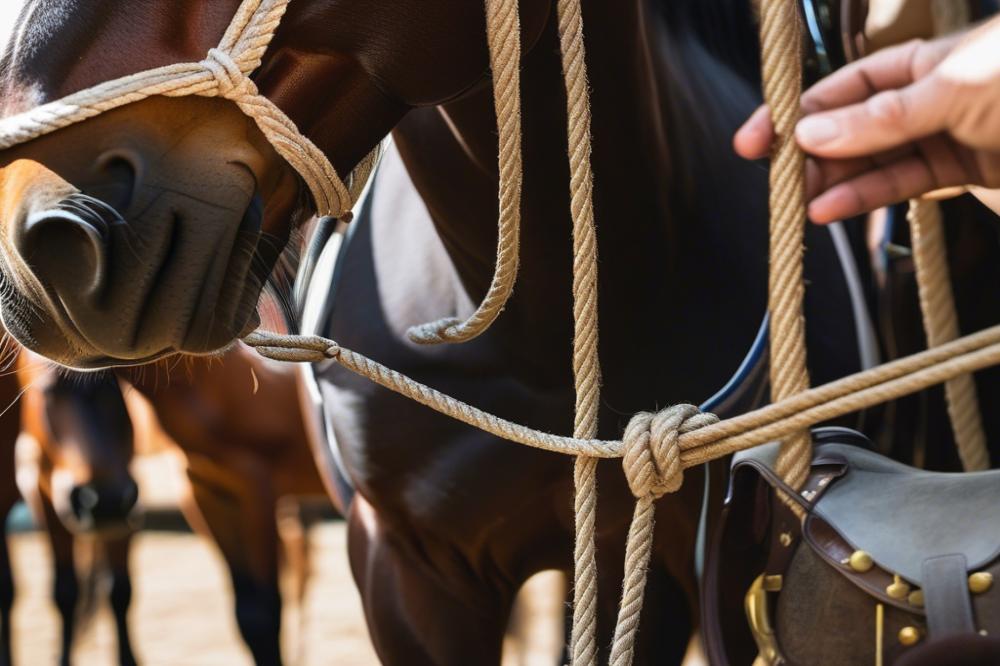Why Tying Up a Horse Matters
Tying up a horse is an essential skill for anyone involved in horse care and handling. Imagine for a moment you are at the stable, and your horse is ready for grooming or a quick check-up. In such situations, having the knowledge to securely tie your horse not only keeps your equine friend safe but also allows you to go about your tasks without worrying. Think of it as putting on a seatbelt before a car ride—it’s just smart practice!
Safety plays a crucial role when it comes to horse training. An untied horse can be unpredictable, which can lead to accidents for both the animal and the handler. Horses are naturally curious creatures; they might decide to take off down the street if they sense the slightest opportunity. So, while it’s important to master equestrian techniques, it’s equally vital to practice safe horse tying methods. After all, you wouldn’t want to find yourself asking, “Can a camel run faster than a horse?” during a runaway incident! That could be quite the surprise.
This article aims to provide you with some fundamental insights on properly tying up your horse. We’ll walk you through practical tips, techniques, and safety precautions that can help make horse handling more effective and enjoyable. Whether you’re a seasoned equestrian or someone exploring the right age to start riding a horse, understanding how to tie up a horse truthfully elevates your ability to care for these magnificent animals. Let’s dive in!
Understanding Tying Up

Definition of Tying Up a Horse
Tying up a horse means securing the animal with a rope or a lead line, often while you’re busy with something else. It’s a common practice in horse care. The goal is to keep the horse in one place, so you can safely groom, saddle, or chat with a friend about the horse’s latest antics. Imagine trying to wrangle a toddler who just discovered candy; it’s similar! Horses are smart and can get themselves into trouble if they’re not properly tied.
Different Methods of Tying Up
Several methods exist for tying your equine friend. The most popular involves using a quick-release knot. This knot allows you to swiftly free the horse in case of an emergency. Another method is the cross-tie system, which uses two lead ropes fixed to the wall. It keeps the horse from moving side to side, which can be very helpful during grooming sessions. Then there’s the good ol’ hitching post tie-up. You simply tie the horse to a sturdy post, but remember, this requires a bit of experience. Each method has its own flair, and knowing them enhances your equestrian skills.
Common Practices Across Various Equestrian Disciplines
Different equestrian disciplines have their own unique practices for tying up horses. For instance, western riders often tie their horses with a rope, emphasizing practicality and ease. On the flip side, English riders might prefer the cross-tie method, particularly during events. Those in the show jumping world need their horses calm and secure before taking on daunting jumps. The key is to match the tying method with the specific needs of the moment. Regardless of the technique, proper horse handling is critical. Always keep an eye on the horse’s behavior, and remember, staying calm is half the battle!
Choosing the Right Equipment

Types of Halters and Lead Ropes
When it comes to tying up a horse, halters play a significant role. They come in various styles. A basic web halter is simple but effective. Nylon halters are durable and easy to clean. Leather options might look great, but they require more care. Remember, the right halter fits well yet isn’t too tight. A lead rope also plays a part in horse handling. Look for something sturdy but not too heavy. Clip styles can differ. A snap is fun and easy, but a bowline knot can be more reliable. Whatever you choose, practice using it often to build your equestrian skills.
Selecting the Right Tying Location
Finding the ideal spot to tie a horse is not just about picking any tree. Safety should be your top priority. Look for a location free of distractions and hazards. Areas away from heavy traffic can help your horse feel more relaxed. Choose a place that has good footing, too. A muddy area can lead to slips and falls, which can be dangerous. Think about how your horse behaves. If he’s skittish, consider tying him somewhere quiet. The right tying location makes all the difference in horse training and care.
Appropriate Tying Tools and Materials
Now that you know about halters and lead ropes, let’s talk about tying tools. A quick-release knot is your best friend. This knot allows you to free your horse easily if needed. Phillips screws can secure eye bolts in the barn, giving your horse a safe place to stand. If you’re out on a trail, consider a sturdy fence post as an anchor. Some people even use a tie ring, which helps prevent tangles. Always carry extra supplies, like a spare lead rope or halter. Being prepared makes horse handling much smoother. Have a backup plan, just like you would when going on an adventure. You never know what might happen!
Safe Tying Techniques

When it comes to tying horses, safety is key. You want both your horse and yourself to remain safe. Tying up a horse requires a good understanding of equestrian skills. Let’s walk through how to do it properly!
Step-by-Step Guide for Tying Up a Horse
Begin by choosing a solid, safe spot. Look for a sturdy post or tie ring that can withstand some pulling. Next, approach your horse with calmness. A soft voice can work wonders. Always use a halter when tying up; they provide better control than just a bridle. Once you have them secured in the halter, it’s time to grab your lead rope.
Make a loop with the rope. This loop should be about the size of a softball. Slip this loop over the tie point. Now, take the running end of the rope and wrap it around the post. Three wraps typically suffice. Tension can keep it secure, but don’t make it too tight. Your horse needs to feel comfortable. Finally, finish with a quick-release knot. This knot allows for an easy release in case of emergency. Use a little practice to make it second nature.
Common Knots Used in Tying Up
Many knots are suitable for tying horses, but a few stand out for their simplicity. The bowline knot is a popular choice. It forms a fixed loop at the end of the rope. This knot won’t slip, which is handy when your horse shifts or pulls. Another reliable knot is the quick-release knot. This one provides a secure hold but can be released quickly if needed. Practice these knots before your next ride to build confidence.
Positioning of the Horse and Handler During the Process
Always position the horse where you can easily manage both ends of the rope. Stay on the same side as the horse’s shoulder while tying. This placement allows you to guide the horse and keeps you safer if they become startled. Watch their body language. Horses communicate a lot through their movements. If they seem anxious, take a step back. Your horse will appreciate that you’re respecting their space.
As the handler, make sure you have a solid stance. Feet shoulder-width apart provides balance. If your horse starts to pull, being grounded helps you maintain control. Keep your eyes on your horse, too. If they move suddenly, you’ll be ready to react. Trust me, it’s better to be safe than sorry!
Tying a horse properly is an essential part of horse care. It’s all about using good equestrian techniques and understanding horse handling. The next time you find yourself with a rope in hand, don’t stress. Follow these steps, and you’ll impress your friends and your horse!
Common Mistakes to Avoid
Tying up a horse can seem simple, but mistakes happen more often than we’d like to admit. One common error is using the wrong knot. Horses can easily untie themselves, and that can lead to trouble. Always pick a knot that holds securely but is still easy to untie. Round pens are great for learning equestrian skills, but don’t forget to practice knots.
Pitfalls in Tying Up a Horse
Horses are creatures of habit. If you always tie them in the same place, they might develop anxiety. Sudden movements can frighten them, leading to panic. Leaving too much slack in the rope can also be risky. A frightened horse can get tangled, causing injury. It’s like leaving a toddler alone with a box of crayons—chaos is bound to happen.
Consequences of Improper Tying Techniques
Improper techniques can lead to serious issues. If a horse pulls back hard, it may injure itself or break the halter. Imagine the surprise when a horse decides to bolt! This can create an unsafe situation for both the rider and the horse. Remember, safety should always be a priority in horse care.
Tips for Preventing Accidents and Injuries
Preventing issues is key to effective horse handling. First, always check your equipment. A frayed rope can break easily. Second, tie horses with a quick-release knot. This way, you can act fast if something goes wrong. Third, let the horse get used to the area before tying up. Give them time to explore their surroundings, which is part of solid horse training.
Using a tie ring or a safety knot can also help keep everyone safe. Take your time during sessions, especially when teaching young horses. Patience goes a long way, and building trust is essential. Lastly, keep an eye on the horse while tied up. Don’t get too distracted; it’s easy to lose focus, like when your friend tells a really long story!
Recognizing Stress Signals
When it comes to handling horses, paying attention to their body language is crucial. Horses are not great at verbal communication, so they use their bodies to express how they feel. A sudden change in posture can say a lot. For instance, if a horse stands with its ears pinned back, that can be a clear sign of discomfort or irritation.
Another indicator is the tail. A horse swishing its tail may be annoyed, while a tense tail can suggest nervousness. Watch closely. If the horse starts to stomp its feet, you might be looking at a horse that’s feeling restless or anxious. Additionally, an agitated horse might paw the ground. This is a strong signal that something isn’t quite right.
Interpreting Body Language
Understanding equestrian techniques requires more than just experience; it demands keen observation. A horse that throws its head up high may be startled or worried. Similarly, if it keeps chewing or licking its lips, those could be signs of stress. Horses often show their feelings through subtle movements. One moment they’re relaxed, and the next they could be hinting at their discomfort through small shifts in their stance.
Eye movements are also telling. A horse with wide-open eyes and flared nostrils might be genuinely scared. Meanwhile, a lower head, along with relaxed ears, often indicates that the horse is calm. Remember, those signs change quickly, so stay alert.
Responding to Stress
Reacting to a horse’s stress signals is essential in proper horse care. If you notice stress, your first move should be to assess the surroundings. Is there something or someone causing anxiety? Sometimes, it could be a simple distraction like a loud noise or other animals nearby. If possible, move the horse to a calmer environment.
Don’t forget to speak softly. Horses can pick up on your tone of voice. A comforting word or gentle pat can go a long way. If the horse is tied up and showing signs of serious distress, consider loosening the tie, if it’s safe. After all, horse handling is about building trust.
Training sessions can include desensitizing horses to common triggers. Over time, the goal is to help them respond better to situations that might previously have caused anxiety. Always remember, patience is key here. Healing doesn’t happen overnight, and every horse is unique.
Much like people, horses thrive on routine. If they’re used to certain cues during horse tying, try to keep things consistent. Predictability creates a sense of security. Use your equestrian skills to improve their comfort level. Observing and adjusting can lead to a more harmonious relationship.
Alternative Methods and Best Practices
Alternative Techniques for Managing Horses Without Tying
When it comes to handling horses, tying them up is not always necessary. Some horse trainers and caretakers prefer to use ground manners to keep their four-legged friends in check. Teaching a horse to stand politely without being tied can be a game changer. You can accomplish this with consistent practice and positive reinforcement. Imagine the freedom your horse feels!
Another option is to use a portable “blocker” tie ring. It allows the rope to slide when needed. If the horse gets startled, the rope can release. This is safer than traditional methods. No more worries about the horse pulling back too hard.
Innovative Products for Equine Safety
In today’s market, you’ll find all sorts of tools for better horse handling. Safety should always come first. For instance, consider using a breakaway halter. These halters are designed to snap under pressure, reducing the risk of injury to your horse. They are a popular choice among experienced equestrians.
Some people also use horse mats or portable pens. Both give horses a secure place while allowing the handler to work comfortably. These products can help create a safe environment for grooming and other activities without the need for horse tying.
Recommendations from Experienced Equestrians
Many seasoned horse handlers swear by patience and calm energy. Having a relaxed demeanor can significantly impact a horse’s behavior. “It’s all about making them feel at ease,” says one trainer with a twinkle in their eye. Clear communication is vital. Pulling, yanking, or scolding only frightens horses more. Building trust takes time but pays off in the long run.
Practicing proper equestrian techniques is essential in daily horse care. Using a lead rope to guide your horse when walking can be just as effective as tying. Just remember, keeping the horse engaged with treats or gentle words helps maintain their focus.
Experienced equestrians often stress the importance of being mindful of the surroundings. A busy area can make any horse nervous. Try to find a quiet space for grooming or other activities. It will pay dividends in a calm horse and a smoother experience altogether.
Wrapping Up with Horse Tying Techniques
As we reach the end of our journey through the world of horse tying, let’s take a moment to recap the essential points. Remember, having a solid understanding of how to tie up a horse is not just about the knots you choose, but also about being mindful of your horse’s comfort. No one wants to be that person whose horse decides to have a little escapade because they weren’t properly secured.
Using the right approach is important for safety and the well-being of both you and your horse. Nobody wants a runaway! A good knot, like a bowline, can be your best friend here. It holds firm yet allows for quick release when needed. Also, always tie at a safe height to prevent the risk of your mount getting tangled in the rope. This kind of forethought helps to treat our steeds not just as animals but as companions—like mythical creatures who deserve our utmost care.
Don’t forget to be aware of your surroundings as well. The horse’s environment can be filled with potential distractions that could lead to unexpected behavior. After all, just like us, they have their moments of flightiness! Ensuring a calm and safe setting makes the whole experience more enjoyable for both of you.
Moreover, practice makes perfect. The more you engage with your horse and develop your skills in horse management, the smoother your routines will be. Maybe your friend has a horse, and you two could even have a friendly competition to see who can tie a better knot—or just have a good laugh attempting to do it! Practice leads to confidence, and before you know it, you’ll be handling your horse with the grace and skill of someone well-versed in english horse riding disciplines.
In conclusion, remember, every time you tie up your horse, you’re not just securing them for a moment. You’re building a relationship, fostered by trust and care. So go ahead, put these techniques into practice and make the most of your time with these magnificent animals. With a little patience and effort, you’ll find that managing your horse can be a rewarding experience that brings joy to both you and your horse. Happy tying!



